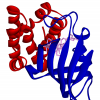Some of the scientist involved with this are thinking once the aging reverses some and repairs happen, that this might then continue by itself for a period. Hypothetically, if you actually reversed to say 20 or younger it would be a reset of the clock, and an all new countdown would have begun and no real need to continue treatments for a very long while.
I don't see GDF11 as going to be that great, as blood transfusions, because there are probably more than just GDF11 that are involved in keeping us younger for awhile to increase the safety and enhance the results. There could be a negative with this though depending on how this actually works in humans, because of telomere length. Would it be calling up old stem cells with already short telomeres?? That would not be good. Of course it could be calling on embryonic stem cells we still supposedly have in our bodies throughout life, and that would be very very good.
As far as I am concerned short telomeres are the problem, so we may need to get the modified molecule of messenger RNA (mRNA), as used as Stanford, to trigger large amounts of telomerase first and then do the Blood/GDF11 in humans. That is assuming that molecule worked the same way in our bodies, as it does in the lab. Maybe even spike the punch so to speak and put it in the new young blood before it we put that blood in people. There are some things I certainly don't know, and whether that would work at all is one of them.
As I have already posted, studies with mice where they transfuse young plasma into old mice once per week FAIL TO CHANGE LIFESPAN:
http://www.ncbi.nlm....les/PMC4215333/
The only plasma studies that work involve heterochronic parabiosis. It's critical to understand that the reason this works - whereas once-per-week transfusions fail - is probably because parabiosis guarantees a constant supply of the relevant proteins to the old mice. The GDF11 and oxytocin studies that reach good endpoints involve *daily injections* of the protein. Again, it's consistent with the parabiosis results. The old animal apparently needs these rejuvenating proteins every single day, or the rejuvenating effect does not happen.
I think people need to stop thinking that plasma transfusions are going to make old people young, because the research says you would need *daily* transfusions of plasma for this to regenerate tissue. These are not risk-free procedures, and there is not enough young plasma in the world to give daily transfusions to old people. What is the point of an old person rejuvenating their muscle and neurons, only to die or become severely ill from a blood-borne pathogen during one of those daily transfusions? It's all very interesting for research, but common sense should tell you this is not a successful strategy for the human population at large.
People keep saying that the changes to the old mice are permanent. Where is the evidence for this claim in the studies? Amy Wagers has expressed an opinion in an interview that this may be true. Where is the proof?
I would also say let's understand what GDF11 can and cannot do on its own before we start developing hugely complex hypotheses and experiments involving both GDF11 and telomeres. There is plenty of runway to be had in just studying these rejuvenating proteins they have - and will continue to - identify. This is not saying you are wrong or right. It is saying it is bad science to simultaneously introduce more than one independent variable into each experiment. It is like those hideous nutrition studies that try to combine some metabolite together with exercise, and then the study conclusion incorrectly tries to draw conclusions from that. Test the metabolite alone, or test exercise alone, and don't create messy experiments that combine the two and therefore make it impossible to draw any real conclusions about either independent variable.
Edited by pone11, 07 March 2015 - 08:26 PM.























































